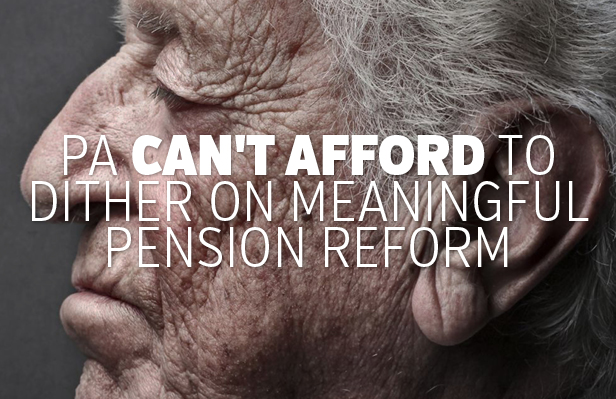Commentary

PA Can’t Afford to Dither on Meaningful Pension Reform
Note: This commentary was originally published in The Delaware County Daily Times. A version also appeared in The Patriot-News.
Is your family ready to pay nearly $900 more in property taxes and state taxes per year? Are you prepared to see 33,000 public school teachers in Pennsylvania — nearly one out of every three — lose their jobs? Those are the realities facing taxpayers and educators if we don’t get a handle on our public pension costs.
The state’s two pension systems, for state government workers (SERS) and public school employees (PSERS), together have more than $47 billion in debt. It’s a shortfall that taxpayers must cover. Recent legislation delayed the day of reckoning, giving lawmakers time to find a real solution, but the bill is quickly coming due.
Current projections show that state and school district contributions will increase from $2.5 billion in 2012-13 to $6.2 billion in 2016-17, representing $877 per Pennsylvania household or the salary of 33,000 teachers (based on average statewide salary). We can’t afford to simply sit by and do nothing.
School pension costs are split between school districts and the state, with some districts hit harder than others. In the Philadelphia region, property taxes are expected to rise between $244 in Penn-Delco and $626 in Chester Upland annually per homeowner just to pay for rising pension costs. Chester Upland’s pension cost increase equals the salaries of 79 of its teachers — an astonishing 53 percent of classroom teachers.
It gets worse. This summer, Fitch Ratings service downgraded Pennsylvania’s bond rating. This could result in higher interest rates for state projects like road repair, and higher costs for taxpayers.
The reason for the downgrade? Rising pension costs, and the failure to pass meaningful pension reform.
Finding the right solution requires examining how we got here. In 2001, lawmakers retroactively increased benefits for themselves, state and school employees. The following year, the Legislature passed a cost-of-living adjustment for retirees. Both increases added billions to our pension debt, and we are still making payments to cover those added costs.
Major stock market losses during recessions in 2001 and 2008 added tens of billions more in pension debt. Following these stock market declines, lawmakers voted to defer payments to avoid tax hikes — shifting these costs, with interest, onto the future. These three factors — investment losses, underfunding, and benefit increases — in relatively equal portions created this crisis.
The origins of the crisis show why the current system is flawed. First, defined benefit pensions create perverse political incentives. It makes political sense to increase benefits for current workers (voters) and transfer costs onto future generations. A child born today will be paying for our current pension deficit well into adulthood.
Further, forecasts of pension costs are just estimates. Pension fund managers project how much pensions will cost taxpayers, assuming a certain rate of stock market gains (currently 7.5 percent). When these guesses prove wrong — as they have often over the past few years — taxpayers end up owing more. A lot more.
The first step to fixing this crisis is to put new employees into a 401(k) model, also called a “defined contribution” plan. In this plan, workers put a portion of their salary towards retirement and taxpayers also contribute a set amount.
Such change wouldn’t take anything away from retirees or from current workers. We must ensure we provide for the benefits individuals have already earned, while creating a sustainable and affordable system for future employees.
Defined contribution plans would get politics out of pensions. Because funds are deposited into an employee’s personal account, it becomes impossible to increase benefits without paying for it, and “underfunding” requires telling workers that you simply aren’t making the required deposit in their account. Such a transparent plan prevents the political manipulation that has plagued traditional pensions.
Moreover, 401(k) plans offer convenience for employees. Younger workers especially would benefit from the ability to take a 401(k) with them as they change jobs. Putting retirement funding on a sustainable path will protect workers by ensuring the system doesn’t collapse, as happened in Detroit.
Once we stop growing our pension debt, we can find a reasonable plan for paying it off. Because of the scope of this crisis, it must include curtailing the growth of other state spending (particularly welfare fraud and abuse), adopting cost-saving measures like prevailing wage reform, and prioritizing our guaranteed pension payments over other “wants.”
Doing nothing is not an option. Allowing new workers to enroll in a 401(k) plan avoids the guesswork and political manipulation rampant in the current system and puts pensions on a path to sustainability.
# # #
Nathan A. Benefield is director of policy analysis at the Commonwealth Foundation,
Pennsylvania’s free market think tank.